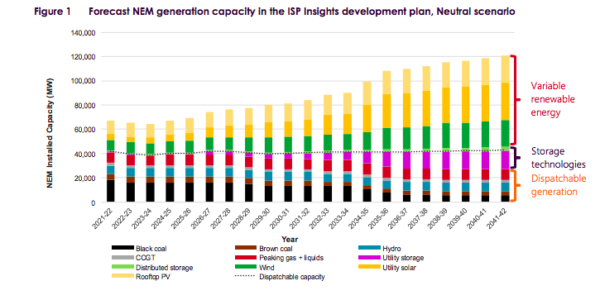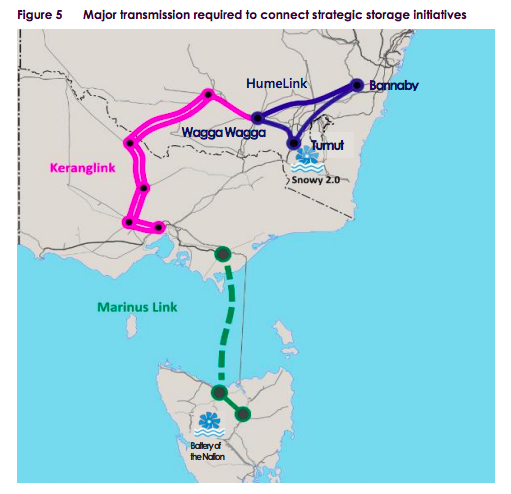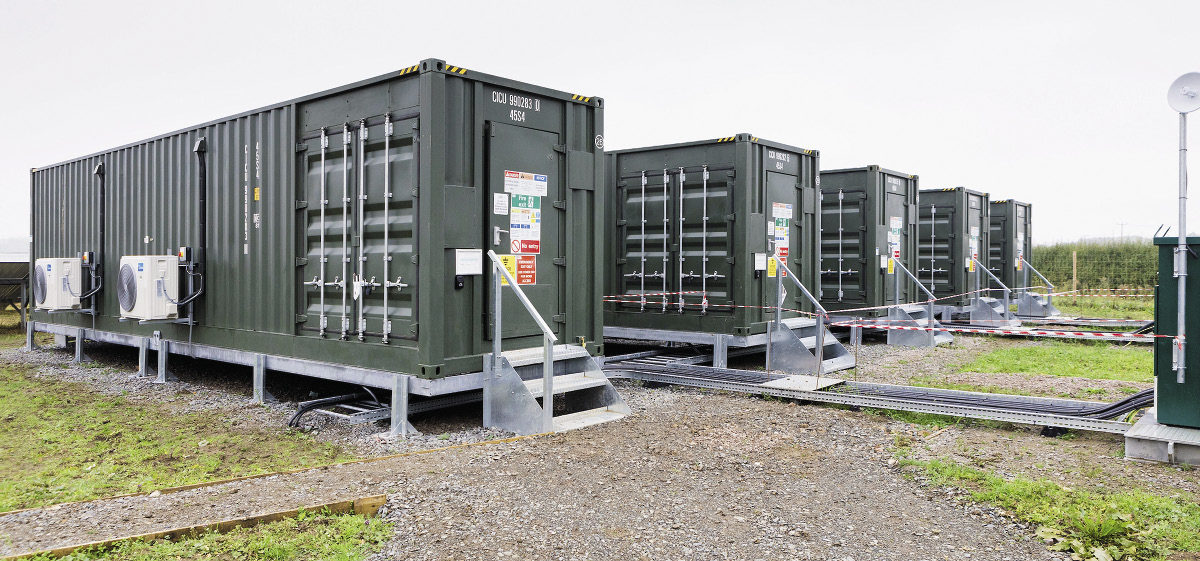From pv magazine Australia.
Rising volumes of intermittent renewable energy in the grid and the declining reliability of legacy generation assets are changing the way the power system will be operated.
The Australian Energy Market Operator (AEMO) is leading the way to renewables supplying 60% of the energy mix within 20 years and has highlighted the importance of optimizing investment in new generation capacity and networks while adopting technologies such as rooftop solar, demand response and electric vehicles.
In the first of a series of insights papers which will precede the second version of its Integrated System Plan (ISP) – due for release in mid-2020 – AEMO has provided deeper analysis of the role of storage. The study assumed 4.1 GW of storage capacity would be installed by 2030 and found the associated need for storage to help energy shifting would reach an unprecedented level a decade later.
The energy market operator forecast the need for utility scale storage would top 15 GW by the early 2040s, with opportunities for six and 12-hour storage facilities to complement deeper, utility scale solutions such as 2 GW pumped hydro Snowy 2.0 project and Tasmania’s Battery of the Nation.
“AEMO’s in-depth analysis confirms the important role of energy storage to build power system resilience, improve reliability and to put downward pressure on wholesale cost,” AEMO chief executive Audrey Zibelman said. “An example in the paper outlines that one week’s storage in Snowy 2.0 in 2030-31 saves approximately $86 million (US$59.8 million) more, on average, in fuel costs compared to the equivalent storage capacity with only six hours’ storage.”
With Snowy 2.0 committed, incentives for additional seasonal storage facilities are expected to weaken until further significant coal-fired generation closures occur in the late 2020s to mid-2030s, the study found.
While long-term storage could deliver higher fuel-cost savings, shallow developments with six-to-eight hours’ storage potential – such as Wivenhoe and Shoalhaven – are the most valuable for intra-day and day-ahead energy shifting, complementing generation from utility scale and rooftop solar systems. Distributed storage with shorter discharge times will also play a critical role, providing value through capacity firming to support the grid at peak times, AEMO added.
“The NEM [national electricity market] has to manage the increasing variability of both supply and demand from changing weather patterns, consumer behaviors, growing variable renewable generation and declining reliability of existing generators,” Zibelman noted.
New lines
The insights paper Building power system resilience with pumped hydro energy storage, assumed a diverse generation mix dominated by the increasing integration of renewables, consistent with the ‘neutral’ scenario presented in the ISP strategy document prepared by AEMO last year. By 2042, wind and solar generation, including rooftop PV, is expected to represent around 62% of the NEM’s installed generation and storage capacity and to generate more than 60% of the energy consumed. Intermittent and variable generation sources would be complemented by the increasing development of storage solutions with a variety of capabilities, as shown in the graph below.

“By 2030, wind and solar generators, including consumer rooftop systems, are expected to represent approximately 50% of the NEM’s installed generation and storage capacity, generating over 40% of [the] energy consumed,” said Zibelman. “It is critical we advance the required transmission infrastructure to support the integration of these new resources to ultimately deliver secure, reliable and affordable energy for Australians.”
In the latest study, AEMO identified intra and inter-regional transmission investments needed to connect pumped hydro storage with consumers. Following the closure of the Liddell Power Station in 2022, an increase in the transfer capability of the network between the Snowy region and Sydney (HumeLink) would maximize reliability at the lowest cost for New South Wales consumers. Inter-regionally, strengthening transfer capability between the Snowy area and northwest Victoria and Melbourne (KerangLink), as well as between Tasmania and Victoria (the Marinus Link across the Bass Strait) could also deliver benefits, AEMO reported.

Another insight from the study was that, with a more than a 20% chance of the Yallourn brown-coal generator closing earlier than its planned 2028-29 shutter date – or in the event of an equivalent supply reduction in Victoria – building KerangLink before the closure date would be the best strategy. “[The] Marinus Link would similarly increase system resilience in case of early plant closure,” added the AEMO study.
KerangLink and/or Marinus Link would provide additional market benefits to consumers. AEMO stated those new interconnectors would reduce the transmission costs involved in integrating renewable generation, reduce the decline in marginal loss factors and increase power system security.
“Transmission augmentations require significant planning, community consultation and economic cost-benefit analysis in the form of the regulatory investment test for transmission (RIT-T), to ensure investments are in the best interest of all consumers,” said chief exec Zibelman. “However, recent independent analysis conducted by Aurora Energy Research concluded an approximate $3.8 billion potential reduction in power bills if developments proposed in AEMO’s ISP were implemented, predominantly through increases in competition and market efficiency via additional interconnection investment.”
AEMO is working with the Energy Security Board and other market bodies to develop a package of changes to the National Electricity Rules to convert the ISP into an actionable national strategic plan. “A key objective is to enable projects identified in the ISP to undergo a streamlined RIT-T and regulatory approval process, that builds on the detailed cost-benefit analysis undertaken as part of the ISP,” added Zibelman.
This content is protected by copyright and may not be reused. If you want to cooperate with us and would like to reuse some of our content, please contact: editors@pv-magazine.com.




They Will use HVDC (High Voltage Direct Current) trasmission linea that are more efficient and transfer more power? I hope that by that date new better conductive material ( with lower loss of energy) for trasmission lines will hit the market.
If one used locally, located solar PV and wind generation with energy storage like the ‘advertised’ TESLA MegaPack distributed along the grid infrastructure, according to Elon Musk, you could put in one of these MegaPacks in three months on three acres. You could get your 15GW of distributed energy storage with 30 of these units and get an 8 hour storage resource for daily use. This could be done in four years.